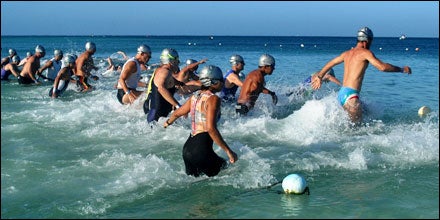START HERE: YOUR FIELD TEST
Serious tri geeks use lactate-threshold tests and power meters to set training zones. But to follow our guide, all you need is a heart-rate monitor. Here’s what to do: 1. Pick a flat, three-to-five-mile running route. 2. Wear a heart-rate monitor and run as if you were racing. 3. Check the monitor at the end. Your average heart rate is roughly your “threshold pace,” which you’ll use to gauge effort. 4. Repeat this test before each training stage in the plan starting on the next page. Your pace should get faster while your average heart rate increases.
DON’T SWEAT THE SWIM
For most new triathletes, the swim is the most daunting task. But it’ll probably make up less than 20 percent of your total race time. This means experienced competitive swimmers barely have to worry about training. For the rest of us, here’s how to survive those 1,500 meters: 1. Start with a pro coach (you can find them through United States Masters Swimming; ). Technique is everything. 2. Ignore people who say you should just stroke and save your legs for the bike and run. A consistent, stable kick is your base. 3. Learn to breathe on both sides (waves can come from anywhere), and breathe a lot. 4. If it feels easier, you’re doing it right. 5. Being comfortable poolside means one less excuse to skip your workout, so ditch the banana hammock and go with the Tyr Poly Mesh Trainer shorts ($33; ).
TRIM YOUR TWEENERS
Want to cut ten minutes off your race? Plan and execute a smooth transition. 1. Study the transition area the day before the event. Know how to find your slot among the thousands. 2. Develop a simple organizational system. Some suggestions: helmet upside down on your handlebars (not clipped), sunglasses inside the helmet, shoes beneath the bike, and a small duffel for gear after it’s used. 3. Practice going through the motions with your race gear until you can do it without thinking. 4. Chill. Spend the last moments of your swim and bike mentally preparing for the transition. Then calmly do it right.
FILL ‘ER UP: YOUR PRE-RACE MEAL PLAN
1. Two days beforehand, carbo-load. Cereal, wheat bread, soy milk, and cooked vegetables are good. 2. The day before, eat dinner at 5 p.m. Again, lots of carbs. 3. The morning of the race, eat more than 150 grams of carbohydrates three hours before start time. 4. Thirty minutes before start time, eat a gel. 5. Down 24 ounces of a sports drink per hour during the bike and run. 6. After you finish, high-carbohydrate snacks and lots of water will jump-start the replenishment process. But beer tastes better.
Slack Attack
The author wanted to race, but he refused to suffer. In the end, his train-by-feel approach worked out just fine. (We think.)
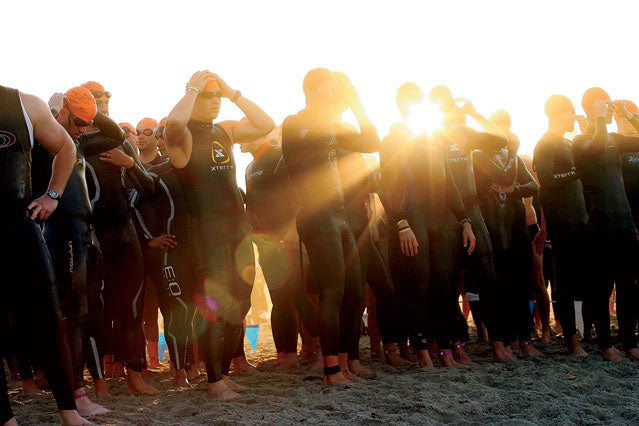
THOUGH I CONSIDER myself an athlete, I’ve never followed a disciplined training regimen. Mileage, heart rate, lactate thresholdÔÇöthese are things that turn sport into work. So when I decided this past winter to sign up for the New York City Triathlon, an Olympic-distance event (1.5K swim, 40K bike, 10K run), it was with some trepidation. Besides being notorious gluttons for pain, triathletes have a reputation for being numbers-and-gadgets junkies. And they are. I saw for myself when I began training with Cadence Cycling & Multisport, a Philadelphia-based group that expanded into Manhattan last year. The coaching staff includes pro triathletes and cyclists, and Cadence’s swank Tribeca facility is outfitted with enough carbon fiber and blinking, bleeping computers to design the next bionic man.
At first, I did exactly what my coaches prescribed. I attended indoor cycling classes and fixated on my pedaling cadence. I wore a heart-rate monitor on runs. But about a month in, just as I was turning into that guy who takes over dinner-party conversations with lectures on training zones, I caught myself. Looking over notes from an early session with my swimming coach, I saw a quote I’d scribbled down: “The numbers are great, but you can also feel what your body is going through.”
That seems pretty obvious, but it’s easy to forget when you’re toggling through settings on your power meter. For me, it immediately became a reassuring mantra: Train by feel. This meant sometimes leaving the heart-rate monitor in a drawer, or running even if my daily coaching e-mail said to bike, or just sleeping in and watching the game no matter what.
So I slacked off a little. Or a lot. But you know what? My program worked. By week nine, I was feeling downright awesome. On one gorgeous Sunday, I went for a five-mile run in Central Park, then biked an hour over to Brooklyn. I woke up the next day feeling strong, so I ran two miles to the pool, swam for 30 minutes, and ran home. Then I biked the 20 minutes to work.
Surprisingly, my coaches supported my method. Mikael Hanson, Cadence’s tri┬şathlon guru in New York, suggested I focus on simple principles (“to race faster, you gotta train faster”). The result was a fluid program that became part of my everyday life. I was exercising up to ten hours a week, but on my terms.
This, it turns out, is the open secret of triathlon training: It doesn’t have to be agonizing to work. In fact, follow the simple stages laid out here and it’s actually kind of easy. Take it from me: I’ve got just over six weeks until my first race, and I’m going to cut today’s ride 20 minutes short so I can catch Iron Man. And I still feel awesome.
Basic Training
Presenting a completely sane three-stage plan to get you ready for an Olympic-distance triathlon
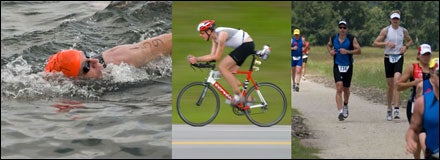
Cutting to the Core
A solid core improves your swim stroke, riding position, and running posture. So should you add long strength routines to your schedule? SureÔÇöif you have time. I didn’t. A simple fix: Cut ten minutes off every other run and bike for crunches (3 sets of 15) and planks (3 at 30 to 60 seconds).
Stage One:
THE FIRST FOUR TO SIX WEEKS
Your initial challenge is to commit to a schedule: You need to train at least four days a week, and on some days you’ll want to mix in a light swim the same day as a bike or run. In the beginning, your workouts should be at a slow endurance pace. (Your endurance pace will be 40ÔÇô50 percent of your maximum effort: Your heart rate should reach 70ÔÇô90 percent of your field-test heart rate, and you should be able to hold a conversation.) Resist the urge to go faster here; you’re building a foundation. Your stage goals: improved technique and endurance.
SWIM (1) It’s fine to start splashing out laps, but do sign up for some basic technique coaching. You should come away with several kick-focused technique drills. Split your workouts equally between drills and laps. (2) Kickboards and flippers are your friends. Use them to build good kick technique. (3) Frequency is more important than duration (or distance). Try for two 30-minute sessions a week.
BIKE (1) Ride a minimum of two days a week for at least an hour, at endurance pace. If you’re already in biking shape, push one ride to 90 minutes or more, and make the other ride a speed or power ride. (See Stage Two, next page.) (2) Practice good form: Your heel should be higher than your toes at the top of the stroke and lower at the bottom; pedal in circles as opposed to mashing up and down. Don’t slouchÔÇöpress your lower spine toward the top tube.
RUN (1) Running development parallels that of biking throughout your training. Start with two runs a week at endurance pace (note that your heart rate will be higher than when riding, since running is more aerobically taxing). If you’re reasonably fit, try to last an hour. But it’s fine to do the first three weeks at 30 to 45 minutes if necessary. Again, focus on training time, not distance. (2) When possible, run on dirt trails and other soft surfaces to spare your knees. (3) Good running posture: Straight up, with even-paced strides that meet the ground beneath your torso.
Stage Two:
THE NEXT FOUR TO SIX WEEKS
You’ve built an endurance base; it’s time to work up to race distances and longer, and start developing speed and power. This is the high-volume stageÔÇöyou’ll be training five to six days a week. Follow big days with easy days. When in doubt, fall back on endurance-pace efforts. Your stage goals: endurance, power, and speed.
SWIM (1) Keep up the drills, but steadily increase full-stroke swimming to 65ÔÇô75 percent of your pool time. (2) Measure progress by your comfort level and gradually increase the distance you can go without stopping.
BIKE (1) Commit to at least one long endurance ride a week (probably on weekends); two hours is the minimum. (2) Develop power by climbing. On an hourlong ride, spend the middle 40 minutes going uphillÔÇöalternate between spinning in an easy gear and cranking in a hard gear. More spinning and less cranking is better for now. Push at about 75 percent of maximum effort (90ÔÇô100 percent of your field-test heart rate). (3) Speed workout: Find a flat stretch of road and sprint at 75 percent of max effort for three to five minutes, then recover at endurance pace for three to five minutes. Repeat sprints and recoveries for a total of 40 to 50 minutes. (4) Always warm up and cool down with at least ten minutes of easy, flat spinning.
RUN (1) Go for at least one slow, hourlong run a week. (2) For your one or two other weekly runs, do either a power or speed routine. For power workouts, run six to eight 45-second repeats up a hill, maintaining your standard running pace. Jog down slowly between each repeat. For speed workouts, run four to five four-minute intervals on flat terrain at 75 percent of max effort. Follow each with two minutes of easy jogging. Cool down from both routines with 15 minutes of endurance-pace running.
COMBOS (1) Begin these halfway through, and start easy with a 45-minute ride, then 15-minute run. (2) Build with this mix: six-mile ride, two-mile run, six-mile ride, two-mile run. Short distances are fine. (3) Be creative: Run to the pool to swim, follow a swim with a spinning classÔÇögo nuts.
Stage Three:
THE FINAL FOUR TO SIX WEEKS
It’s time to get faster by upping the inten┬şsity of your speed/power workouts. This means you need more recovery time, so it’s OK to shorten endurance days. But you can’t get any faster the week before your eventÔÇöthat’s a time to hydrate and relax. Your stage goal: preparation for the race.
SWIM (1) Reduce drills to 10ÔÇô15 percent of your pool time as you stretch out distance. At some point, swim at least 1,500 meters without stopping. It’s important to know you can do it. (2) Break up the monotony of laps by using a pull float and paddles. They also build strength and speed. (3) Try to swim at least a few sessions in your race-day wetsuitÔÇöyou’ll be more buoyant and actually use different muscles. If possible, swim in a lake to prepare for open-water variables such as waves, currents, and floating debris.
BIKE (1) If you’re converting your bike to tri position (see “Shift Gears,” opposite), do so early in this stage. You need to get used to the different handling. (2) Up the intensity of your power days. On hills, do more cranking in a hard gear and increase your effort to 80ÔÇô90 percent (100ÔÇô105 percent of your field-test heart rate). For intervals, try two to four minutes at 80ÔÇô90 percent max effort, followed by equal periods at endurance pace.
RUN (1) Increase the intensity from your stage-two power/speed days to 80ÔÇô90 percent max effort and add a few reps. (2) Continue with regular endurance runs and lengthen some to a mile or two beyond the 10K triathlon distance.
COMBOS (1) Try doing a couple of two-sport combos at actual race distances and pace. (2) Sandwich swims or rides between runs (for example: 20-minute run, 30-minute swim, 20-minute run). This lets your legs recover while you ride or swim.
Shift Gears
You don't need a triathlon-specific bike. Many beginners don't use one. Still, the races don't allow drafting, so a more aerodynamic position can really speed you up. Plus it's fun. If you already own a good road bike, consider this simple (and easily reversible) conversion, and get a pro technician at a shop to dial the fit.
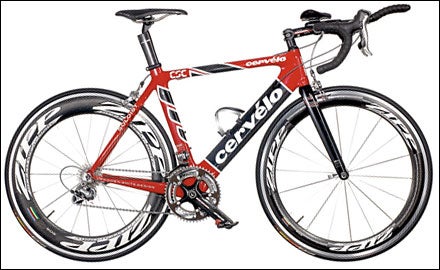
Moving your saddle slightly forward (which may require an offset seatpost) helps you extend comfortably onto the aero bars.
Buying aero wheels is the easiest way to reduce drag. But the seconds saved will cost you: Zipp’s 808/404 pairing () runs $2,210.
Is the down tube the most aerodynamic spot for a water bottle? No. But leaving it here makes drinking easier, which is more important.
Shopping for a do-it-all bike? Go with the Cerv├ęlo Soloist Carbon ($5,000; ), which has road-bike geometry and aero tubes.
Clip-on bars like Zipp’s Vuka Clip ($150) get you aero with minimal mechanic time.
More surface area on aero wheels makes you vulnerable to crosswinds. Be conservative up frontÔÇöthe Zipp 404 rim is a reasonable 55 mm deep.
The Essentials
Everything you need to complete your first tri
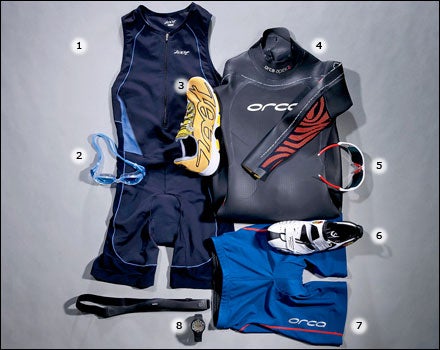
1. On race day, go fast and easy with Zoot Sports’ do-it-all ULTRA Racesuit ($175; ).
2. Blue Seventy’s Vision goggles ($20; ) give you wide-angle lenses for open water.
3. Speed laces and a sock-free design mean a quick entry to the Zoot Ultra Race ($130).
4. Orca’s Apex 2 wetsuit ($550; ) offers superior buoyancy and silicone forearm swatches to boost troke efficiency.
5. The polarized Positive Red lens on Oakley’s Radar ($255; ) cuts glare and repels sweat.
6. Northwave’s Tribal cycling shoe ($170; ) delivers easy access with Velcro on the top strap to hold the upper open during transitions.
7. The Orca 226 Tri Pant ($70) has more padding than most tri shorts but dries fast and doesn’t chafe.
8. Suunto’s t3C heart-rate monitor ($190; ) works equally well for numbers geeks and beginners.
Tri Talk
Master your multisport lingo
BRICK A workout consisting of a bike ride followed by a run. So named because when you start to run, your legs feel like bricks.
P.R. Personal record, or the fastest you’ve ever raced an event or given distance.
P.E. Perceived exertion, a technical way to rate how hard you’re working out, usually on a one-to-ten scale.
PEE Considered acceptable in your wetsuit if you’re racing in open water, and even in your tri suit or shorts during the bike or run. (But really, unless you’re trying to win, why?)
STACKING A smart training strategy in which hard days are followed by easier workouts. Damn, that schedule is stacked!
SPRINT A short-distance triathlonÔÇötypically a 750-meter swim, 20K bike ride, and 5K run.
RECOVERY Low-intensity exercise. This is the best way to end a workout, as it maintains blood flow without taxing your muscles. Not to be confused with the more reasonable definition of the term, which involves a burger and sleep.
RIDING STEEP Tilting your saddle forward at an angle to reduce pressure on your perineum. This debatable practice is popular among triathletes, as the aero cycling position shifts a rider’s weight toward the front of the saddle.
T1 The first transition, from swim to bike.
T2 The second transition, from bike to run.
T3 Definitely the worst of the Terminator movies.



